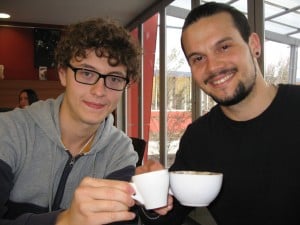Exploring New Zealand’s wine regions on his month-long Bragato exchange scholarship, Alessandro Mangiameli has encountered a few surprises.
From Treviso in Italy’s Veneto region, the 18-year-old says winery machinery and winemaking processes are much the same in both countries but different vineyard practices reflect the local soils and climatic conditions.
Alessandro’s counterpart at EIT, this year’s New Zealand Bragato scholar Jascha Oldham-Selak, will have a like opportunity to check out similarities and differences when he travels to Italy in January.

“Cin cin” – Alessandro Mangiameli and Jascha Oldham-Selak drink to their Bragato exchange scholarship success on EIT’s campus in Hawke’s Bay.
A third-year student enrolled in the concurrent Bachelor of Wine Science and Bachelor of Viticulture, Jascha is looking forward to his first experience of old world wine making.
Ahead of his month in Italy, he will fly into Barcelona to meet up with a friend. The pair will then travel to the Canary Islands, visiting a “wine house” in Lanzarote, and drive through the Italian countryside from Rome.
On his scholarship, Jascha will be visiting wine regions in the country’s northeast and spending time at Romeo Bragato’s alma mater in Conegliano. The legendary viticulturist is celebrated for recognising New Zealand’s potential for growing grapes.
Alessandra attends the same school of viticulture and oenology, which is based in a region known for its prosecco, a sparkling white wine made from Glera grapes.
Visiting the Gisborne, Central Otago, Marlborough and Hawke’s Bay wine regions, he sampled many of the styles associated with this country including Sauvignon Blanc, Chardonnay, Viognier, Riesling, Syrah, Pinot Noir, Merlot, Cabernet Franc, Cabernet Sauvignon and Malbec as well as a number of blends.
“The New Zealand wines are different,” he says. “They have more flavour, more alcohol and more body.”
Alessandra was also interested to taste whites such as Chardonnay and Sauvignon Blanc matured in oak.
Apart from a week-long school trip to Austria, this was his first trip abroad. It’s uncommon for young Italians to travel overseas, he says, and his classmates, whose families typically own wineries, are needed at home to help with harvest.
While Jascha has travelled to Fiji and Australia, his Bragato exchange trip will be his first venture to the northern hemisphere and he’s excited that its focus will be winemaking and viticulture.
Both students attended the Romeo Bragato Conference held in Napier from 26-28 August and they plan to catch up again when Jascha is in Italy.




















